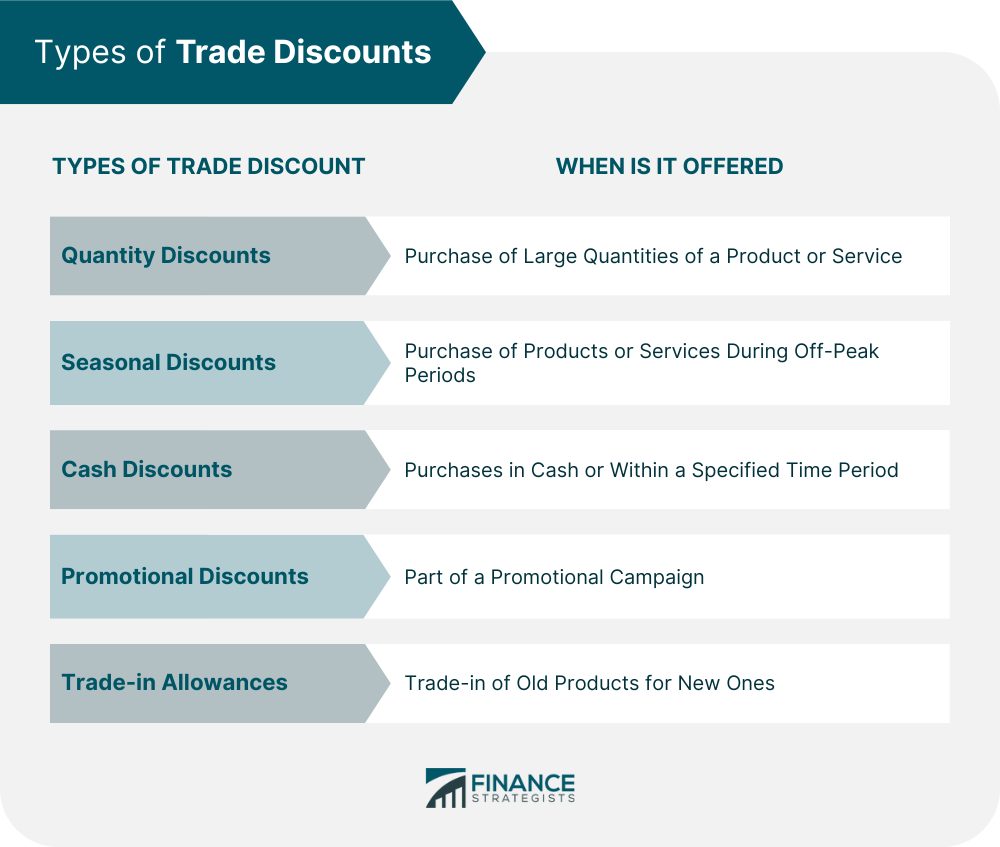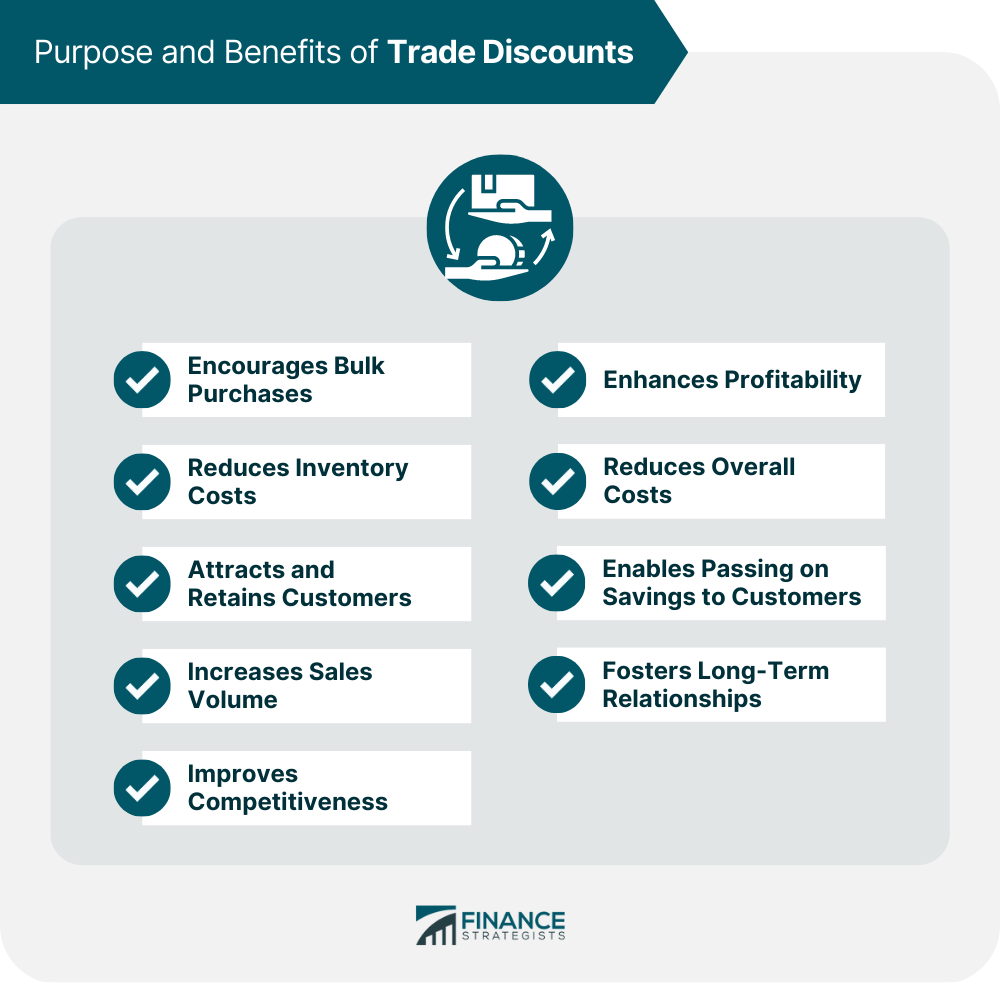A trade discount is a reduction in the list price of a product or service offered to a customer by a supplier. Trade discounts are used to incentivize customers to buy in bulk, purchase products during off-peak periods, or take advantage of other favorable conditions. For example, a supplier may offer a 10% trade discount to customers who purchase 100 units of a product or service. This means the customer will pay only 90% of the list price for each unit. Trade discounts differ from other discounts because they are not usually advertised publicly. Instead, they are negotiated between the supplier and the customer. Also, trade discounts are not applied at the point of sale. Instead, they are reflected in the invoice or receipt after the purchase has been made. There are several types of trade discounts that suppliers may offer to customers. These include: Quantity discounts are offered to customers who purchase large quantities of a product or service. For example, a supplier may offer a 5% discount to a customer who purchases 50 units of a product or service and a 10% discount to a customer who purchases 100 units. These are discounts offered to customers who purchase products or services during off-peak periods. For example, a supplier may offer a 15% discount on lawnmowers during winter when demand is low. Cash discounts are offered to customers who pay for their purchases in cash or within a specified period. For example, a supplier may offer a 2% discount to customers who pay for their purchase within ten days. These are discounts offered to customers as part of a promotional campaign. For example, a supplier may offer a 20% discount on a new product for the first month of its release. These are discounts offered to customers who trade their old products for new ones. For example, a car dealer may offer a $2,000 discount to a customer who trades in their old car for a new one. There are several reasons why suppliers offer trade discounts to customers. One reason is to encourage customers to purchase in large quantities. Suppliers can by offering a discount for bulk purchases. Trade discounts can help suppliers to attract new customers or retain existing ones. By offering discounts to customers who meet specific criteria, suppliers can create a sense of loyalty and foster long-term relationships. Customers also benefit from trade discounts. As a result, customers can reduce their overall costs and increase their profitability by purchasing in bulk or at specific times. For example, a restaurant that purchases food supplies in bulk can reduce its food costs and increase its profit margin. Also, trade discounts can help customers to stay competitive by reducing their prices or increasing their profit margins. The benefits of trade discounts are not limited to businesses. Consumers can also benefit from trade discounts indirectly. For example, when enterprises reduce their costs through trade discounts, they can pass on the savings to their customers through lower prices or better-quality products. The calculation of trade discounts is relatively simple. To calculate the trade discount, you need to know the list price of the product or service and the percentage discount offered. Here is an example: Suppose a supplier offers a 10% trade discount on a product with a list price of $100. The trade discount would be $10 (10% of $100), which means the customer would pay $90 for the product. It is important to note that the trade discount is applied to the list price, not the discounted price. For example, if the product already had a cash discount of 5%, the trade discount would still be calculated based on the list price, not the discounted price. While trade discounts can be beneficial to both suppliers and customers, there are some limitations to consider. One limitation is that trade discounts may not always lead to increased sales. For example, if the customer does not have the financial capacity to purchase in bulk, a quantity discount may not be effective in incentivizing them to buy more. Also, trade discounts may not always be appropriate for all products or services. For example, products with short shelf lives may not benefit from bulk purchases, and seasonal discounts may not be suitable for products that are in high demand year-round. Another limitation of trade discounts is that they may create a sense of dependency on the supplier. If customers become too reliant on trade discounts, they may find it difficult to switch suppliers or negotiate better deals in the future. Trade discounts may not always be the best way to reduce costs. For example, reducing supply chain costs through process improvements or better supplier management may be more effective in the long run. To effectively manage trade discounts, suppliers and customers should follow some best practices. Here are some tips: Suppliers should have a clear trade discount policy that outlines the criteria for offering discounts and the percentage discounts offered. Customers should negotiate trade discounts with suppliers based on their specific needs and financial capacity. Suppliers and customers should regularly review their trade discount agreements to ensure they are still effective and beneficial. Suppliers should be transparent about their trade discount policies and communicate them clearly to customers. Customers should not become too reliant on trade discounts and should explore other ways to reduce costs, such as process improvements or better supplier management. Trade discounts are a powerful tool for increasing sales, reducing costs, and fostering long-term relationships between suppliers and customers. They are offered in various forms, including quantity discounts, seasonal discounts, cash discounts, promotional discounts, and trade-in allowances. To calculate the trade discount, you need to know the list price of the product or service and the percentage discount offered. However, trade discounts have some limitations, and suppliers and customers should manage them carefully to ensure their effectiveness. Best practices for managing trade discounts include having clear policies, regular reviews, and exploring other cost-reduction methods. By following these practices, suppliers, and customers can maximize the benefits of trade discounts and improve their bottom line.What Is Trade Discount?
Types of Trade Discounts
Quantity Discounts
Seasonal Discounts
Cash Discounts
Promotional Discounts
Trade-in Allowances

Purpose and Benefits of Trade Discounts

Calculation of Trade Discounts
Limitations of Trade Discounts
Best Practices for Managing Trade Discounts
The Bottom Line
Trade Discount FAQs
A trade discount is a reduction in the list price of a product or service offered to a customer by a supplier. It differs from other forms of discounts such as cash discounts, quantity discounts, and promotional discounts because it is negotiated between the supplier and the customer.
To calculate a trade discount, you need to know the list price of the product or service and the percentage discount offered. The trade discount is applied to the list price, not the discounted price, and factors such as quantity, timing, and conditions of the purchase may influence the discount.
Limitations of trade discounts include their effectiveness in increasing sales, potential dependency on the supplier, and suitability for all products or services. Best practices for managing trade discounts include having clear policies, regular reviews, and exploring other cost reduction methods.
Trade discounts can benefit suppliers by increasing sales volume, reducing inventory costs, and attracting and retaining customers. They can benefit customers by reducing overall costs, increasing profitability, and enhancing competitiveness.
Suppliers and customers can negotiate trade discounts effectively by understanding their specific needs and financial capacity, exploring alternative cost reduction methods, being transparent about their policies and needs, and regularly reviewing their agreements.
True Tamplin is a published author, public speaker, CEO of UpDigital, and founder of Finance Strategists.
True is a Certified Educator in Personal Finance (CEPF®), author of The Handy Financial Ratios Guide, a member of the Society for Advancing Business Editing and Writing, contributes to his financial education site, Finance Strategists, and has spoken to various financial communities such as the CFA Institute, as well as university students like his Alma mater, Biola University, where he received a bachelor of science in business and data analytics.
To learn more about True, visit his personal website or view his author profiles on Amazon, Nasdaq and Forbes.











